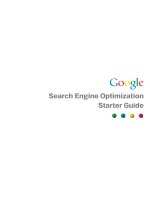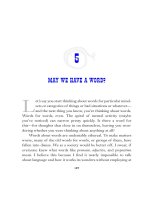We have a Web site On-Page Search Engine Optimization Practical Advice pdf
Bạn đang xem bản rút gọn của tài liệu. Xem và tải ngay bản đầy đủ của tài liệu tại đây (867.93 KB, 18 trang )
We have a Web site. Now What?
Part 1: On-Page Search Engine Optimization
Practical Advice to Improve Your Online Marketing Eorts
Craig Rentmeester
Introduction 3
The Example: Mayo Clinic – Sore Throat
Google Search Results 4
Google Search Results with explanations 5
On-Page Search Engine Optimization
Content 6
Page Titles 7
URLs 8
Header Tags 9
Link Structure 10
Internal Links 11
Images 12
Keywords Meta Tag 13
Description Meta Tag 14
Sitemaps 15
PDFs 16
Resources 17
Bonus 18
Contents
Introduction
Why do organic search rankings matter?
1. For many people, search engines are the starting point for information on
buying decisions.
2. There are billions of searches down every month and that number is
growing. (Over nine billion searches in August, 2007 – a 28% increase
from August 2006.)
3. It’s tough to buy trafc. According to the search marketing report by Ad
Age published in 2007, the click through rate of search engine
advertisements is 11.5 percent.
Are there also off-page SEO items that I should know about?
Yes, search rankings aren’t just a result of good on-page optimization.
Search rankings also take into account other factors that aren’t directly in
your control. My next e-book will cover off-page SEO items that inuence
search rankings.
Why are there so many links?
This book is written for someone without a strong technical background.
As such, I’ve provided links to any jargon I used throughout the book. If
you’re curious about a term, follow the link for an explanation.
FYI: Links are in green text.
*If you plan to print this document, print it in landscape mode.
This book is intended to empower entrepreneurs. By using this book as a guide, entrepreneurs can expect to see
greater numbers of targeted trafc to their site(s).
By pointing out how the code appears on the
high-ranking web site, I hope it will allow you to
understand the advice more quickly.
To help with the technical learning curve, I’m
providing an example of the search term
“sore throat” and displaying the underlying
source code from the corresponding web page
from MayoClinic.com.
Disclaimer: I am not afliated with Mayo Clinic in any way,
shape or form. Also, MayoClinic.com did have the number one
search ranking on Google for the phrase “sore throat” when this
book was written in January 2008.
/> />Content
The only surere way to great search rankings is to create great, original content. Search engines do not need, nor
do they reward, duplicate content.
Be focused. Try to have a page dedicated to each keyword or phrase that you’re trying to rank well for. Use your
keywords frequently in the body tags of your pages.
While you should include your keywords frequently in the body tags, do not spam a page by placing text in the
same color as the background or hiding keywords in places that people can’t see. This is a way to get banned from
a search engine or be placed in the supplemental index.
Search engines do not properly index Flash hyperlinks or moving text. Try to avoid having ash-based site
navigation and a ash-only homepage.
Avoid using frames because they don’t allow content to be indexed properly in most cases.
Load times are important both for search engines and for visitors. So, avoid using excessive JavaScript.
The phrase “sore throat” appears eight times on the Mayo Clinic page, including the H1 tag. View the cached page.
Page Titles
Page titles are extremely important for both search engine optimization and for click through rate.
Page titles should contain no more than 5 words that are keyword-centric and directly relate to what is on the
corresponding page.
Using more than ve words in a page title dilutes the strength of each word.
Place important keywords early in the page title. The rst word receives the highest reward.
<title>Sore throat - MayoClinic.com</title>
Search Engines take into account the names of directories and les in each URL where there is content.
Thus, keywords should appear in the directory names and le names.
Static URLs rank better than dynamic URLs.
If you’re going to use multiple words when naming a le or directory use a hyphen, not an underscore, between the
two words. Google tends to ignore underscores, but views hyphens as dividing two distinct words.
/>URLs
Header tags should be used to let both the reader and the
search engine know what is important.
There should only be one of each tag per page, with your most
important keyword appearing in the H1 tag and
descending from there in terms of importance.
Header Tags
H1
H2
H3
Important
Less Important
<h2>Introduction</h2>
<h1>Sore throat</h1>
<h4>ARTICLE SECTIONS</h4>
Link Structure
How your pages link to one another is important.
Important pages on your site should link to one another. If
you have your site broken into distinct sections, the main
pages of each section should link to one another.
The image on the right shows proper link structure between
pages.
This image, courtesy of Search Bliss,
shows proper link structure.
<a href=" Services</a> | <a href="">Health Information</a>
Internal Links
Having internal links to pages to and from one another is important. Even more important is the anchor text used to
describe that link.
The anchor text of each link should contain keywords that relate to what is on the following page.
For example, having a link for a digital camera say “Click Here” does less for SEO than a link that says
“digital camera”, even if each one links to the same page.
<a href="
<a href=" and Research</a>
Images
Search engines cannot “see” what is inside an image. Therefore, most search engines have a hard time properly
indexing images.
To have images help with search rankings, use keywords in the lenames and alternative text in the html to de-
scribe the image.
It is also good to use captions near images. Search engines pickup on the proximity of the text and it helps them
index the image.
<img src="/images/image_popup/thumbs/r7_croupthu.jpg" alt="Illustration showing anatomy of the throat"> <a Sore throat</a>
<img src="/images/nav/logo_mayoclinic.gif" width="278" height="50" alt="Mayo Clinic" border="0" />
Keywords Meta Tag
The keyword meta tag does not have to be present in order to rank well in major search engines.
However, some search engines still utilize this tag for indexing content.
If you plan to use the keywords meta tag, it should contain no more than 7 keywords that are separated by commas.
Just as with page titles, the more keywords used in the keywords tag, the less value is given to each word.
The keywords meta tag should contain words that directly relate to what is on that particular page.
<meta name="keywords" content="sore throat,throat,strep throat,pharyngitis,scarlett fever" />
Description Meta Tag
While a description tag doesn’t help with search engine optimization, it can help the search result get clicked on by
potential visitors.
Each page should have a unique description that sells that particular page’s content. People don’t like surprises, so
keep the description relevant to what is on the corresponding page.
<meta name="description" content="Sore throat — Comprehensive overview covers causes, treatment, self-care of this common afiction." />
Sitemaps
Sitemaps are typically XML les that diagram how a Web site’s content is structured.
Creating a sitemap and submitting it to search engines is a good way to point out how your site is structured and
where pages are located. Sitemaps ensure that all of your pages are found and indexed.
Where to submit your sitemap?
- Google Webmaster Tools - /> - Yahoo! Sitemap Submission - /> - Ask.com - place the url of your sitemap into the link below and it will ping Ask.com.
URL of your sitemap here.xml
- Bing Webmaster Tools - /> (Updated 2009)
/>PDFs
Similar to how search engines struggle to “see” an image, they struggle to understand
what is contained in a PDF.
To Optimize a PDF, open the PDF and go to File>Document Properties. Then,
complete the title tag. You may also complete the Author tag, subject line,
and keywords tag. However, these are much less important than the title tag.
While the PDF is open, go to Advanced>Accessibility>Add Tags to Document.
Then, add meta tags just like you would to a html page.
* To add a page title and add meta tags, you need to use Acrobat Professional.
You should also include your keywords in the PDFs le name.
Sometimes search engines will generate a description of a PDF based on the rst few sentences, so good topic
sentences can pay dividends.
Woops, Mayo Clinic didn’t have any PDFs on this page.
Resources
Below are free resources that I recommend using before and after your optimization project.
Tools
Web site Grader – Submit your URLs and it will tell you how well your site is optimized.
Submit Express’ Meta Tag Analyzer – This tool will tell you how well your meta tags relate to each page’s content,
pointing out SEO aws in your meta tags.
Submit Express’ Keyword Suggestion Tool – This free tool utilizes data from Wordtracker and KeywordDiscovery
to suggest keywords related to the words you provide.
XML-Sitemaps – Sitemap generator. *This tool may not work properly on Web sites with over 100 pages.
SEO Chat’s Dynamic URL Converter – This tool converts dynamic URLs into static URLs, but it only works with
Apache servers.
Recommended Blogs on Search Engine Optimization
Search Engine Watch
SEO Moz
HubSpot
Bonus
Thanks for reading. I hope you learned a thing or two.
Whether or not you liked this e-book, I’d appreciate it if you critiqued my work.
Please take the short, eight question survey.
About the Author
• Craig Rentmeester is a graduate of the University of Minnesota.
• Craig currently lives in Minneapolis, MN.
• Craig is the founder of Relevante Marketing, LLC.
• Craig keeps an active blog about marketing, PR, advertising and new media.
If you have questions, are interested in working with Relevante, or would like to say hello, you can e-mail Craig at
Thanks,
Craig Rentmeester
Relevante
Internet Marketing Systems









